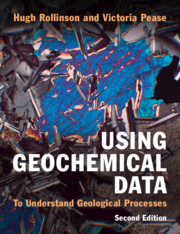Book contents
- Using Geochemical Data
- Reviews
- Using Geochemical Data
- Copyright page
- Contents
- Preface to the Second Edition
- Preface to the First Edition
- Abbreviations
- 1 Geochemical Data
- 2 Analysing Geochemical Data
- 3 Using Major Element Data
- 4 Using Trace Element Data
- 5 Using Geochemical Data to Identify Tectonic Environments
- 6 Using Radiogenic Isotope Data
- 7 Using Stable Isotope Data
- Appendices
- References
- Index
4 - Using Trace Element Data
Published online by Cambridge University Press: 15 April 2021
- Using Geochemical Data
- Reviews
- Using Geochemical Data
- Copyright page
- Contents
- Preface to the Second Edition
- Preface to the First Edition
- Abbreviations
- 1 Geochemical Data
- 2 Analysing Geochemical Data
- 3 Using Major Element Data
- 4 Using Trace Element Data
- 5 Using Geochemical Data to Identify Tectonic Environments
- 6 Using Radiogenic Isotope Data
- 7 Using Stable Isotope Data
- Appendices
- References
- Index
Summary
The behaviour of trace elements in geochemistry may be understood in terms of the chemical properties of their ions and the way in which they are partitioned between solid (mineral) and melt phases during the melting and solidification of igneous rocks and their sources. However, partition coefficients vary according to a large number of physical parameters such as temperature, pressure, melt composition and oxygen fugacity, and these effects can be modelled using the results of experimental petrology and thermodynamic analysis. Trace element data for both igneous and sedimentary rocks are plotted according to their geochemical properties and may be displayed on bivariate diagrams, rare earth element (REE) plots, multi-element plots normalised to the composition of the Earth’s primitive mantle or as highly siderophile elements (HSE). The physical understanding of trace element distributions means that they can be modelled during partial melting, fractional crystallisation and assimilation and comparisons made with the measured compositions of natural rock samples.
Keywords
Information
- Type
- Chapter
- Information
- Using Geochemical DataTo Understand Geological Processes, pp. 96 - 156Publisher: Cambridge University PressPrint publication year: 2021
